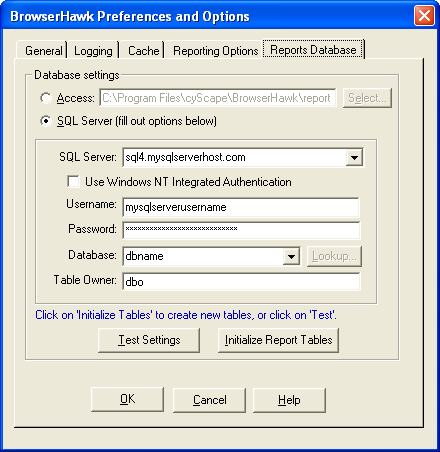
The Reports Database settings tab is used to configure the type and location of the database you want the BRWS to store the statistics in. This tab is also used to initialize the BRWS data tables and test the BRWS database configuration.
Note: Changes made to this tab do not take effect until your web services are restarted.
Note: This entire tab is disabled if you chose to use the BRWS running on a different server. This is because the options on this tab only apply if you are running the BRWS on this server. To enable these options, return to the Reporting Options tab and choose to run the BRWS on this server.

Database Settings:
Use this option to select either Microsoft Access or SQL Server as the type of database the BRWS will use to store the statistics.
Access:
Choose this option to have the BRWS save the statistics to a Microsoft Access database. Enter the full path and filename of the database you want to use. You can use the select button to help find an existing MS Access database.
Tip: If you wish to add the statistics to one of your existing Access databases, select your MDB file using the Select button or enter the full path to it. After you select this press the Initialize Report Tables button at the bottom of the form. This will create the necessary database tables used to store the statistics. If you use the default BHReports.mdb file instead, this step is not necessary as this MDB file already has the tables created for you.
SQL Server:
Choose this option to have the BRWS save the statistics to a Microsoft SQL Server database. Selecting this option requires the following additional information:
SQL Server:
This is the actual name of the server running SQL Server where you want the BRWS to save browser statistics. Select from the list of servers or enter the name of a server, if you don’t see the server you want in the list.
In order for BrowserHawk to populate the field with a list of available SQL Servers in your domain, you need to have SQL Server Distributed Management Objects (DMO) installed on the machine you are running this setup on. SQL Server DMO is installed by the SQL Server and SQL Server client setup programs.
Note: DMO is not required. It is only used to populate a list of options for this field. If DMO is not installed you can just type of name of your SQL Server in this field.
Use Windows NT Integrated Authentication:
Select this check box if SQL Server is configured to use Windows NT authentication. Do not select this option if SQL Server is configured to use its own authentication method.
User name:
If SQL Server is not configured to use Windows NT integrated authentication you need to enter an SQL Server user name for the BRWS to use to connect to the SQL Server database. You will also need to enter a password in the next field.
Password:
If SQL Server is not configured to use Windows NT integrated authentication, enter the SQL Server password for the user name entered in the User Name field.
Tip: The user name and password fields are disabled when the Windows NT Integrated Authentication field is checked. If you need to enter a user name and password unselect the Integrated Authentication option.
Database:
Set this to the name of the database on your SQL Server machine where you want the BRWS to save the browser statistics. This can be any existing database, or you can use SQL Server to create a new database specifically for the browser statistics.
Lookup button:
Press this button to fill the database combo-box with a list of possible databases on the SQL Server machine you select. This feature is available only if SQL Server Distributed Management Objects (DMO) are on the machine you are running setup on. DMO is installed by SQL Server and SQL Server client setups. Without DMO installed you will need to manually enter the name of the database.
Table Owner:
Set this field to a user account or SQL Server user role that will be used by the BRWS to create and access the table used to hold the statistics. This field, in conjunction with the value enter for the Database field, forms the fully qualified name used by the BRWS for accessing the data tables. For example, if you enter dbo for the table owner, and mydb as the Database name, BRWS will use "[dbo].mydb".
Test Settings:
Press the Test Settings button to make sure that you have properly configured the options on this tab. In this test BrowserHawk verifies the settings by writing a test record into the database (which is then removed). If this fails you will be prompted with details on the failure.
Initialize Reports Tables:
Press the Initialize Reports Tables button to create the BRWS data table used to hold the statistics. If you are using the default options of MS Access with the BHReports.mdb database this step is not necessary, as the database already has this table created for you and ready for use.
Note: If you change the options to use SQL Server, or a different Access database, you must press this button to have BrowserHawk create the necessary table (’r;BHSTATS’) and view (’r;BHS’) for you. This operation should only be done once, as these database objects will be dropped and then recreated if they already exist (following your confirmation to do so).
If you have the settings on this tab and do not press the Initialize Reports Tables button or the Test Settings button, BrowserHawk will prompt you that the changes need to be tested and ask you if it may do so.
See Also:
Understanding how BrowserHawk Reports works